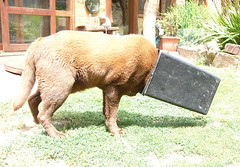Dog diarrhea is never fun, for you or your dog. However, if you know some of the common causes of diarrhea in your dog, you can start to decipher what is causing the diarrhea. Without knowing any of the underlying causes, you may not treat your dogs diarrhea properly, using natural treatments, and cause even more issues in the health of your dog.
A primary cause of diarrhea in dogs, is changing their food to quickly. Unlike humans, who can have a different meal every day, dogs have to be changed slowly to a new food. If you change them too quickly, their systems cannot handle the change. Which will cause diarrhea to start and last until they are adjusted to the new food. Once the dogs are adjusted, the chance is still present for diarrhea. This chance comes from the bacteria in their stomachs might be to weak to help them digest food properly.
Food allergies is another cause of diarrhea in dogs. When dogs are allergic to a food, their bodies can react in several ways. A common way dogs react is by getting the food out of their system as quickly as possible. For example, if your dog is allergic to corn, and the dog get a hold of corn based food, they will pass the food through their system as quickly as possible. Commonly the way the dog will pass this food through their system is by having a touch of diarrhea.
Illness is another issue which may cause diarrhea. Even if the diarrhea was not present before the illness, the medicine your dog is taking can wipe out the natural bacteria. When this happens, your dog will get diarrhea for the same reasons people do. With the natural treatments for the illness, the bacteria in your dogs system is generally not wiped out, meaning no diarrhea.
Finding the underlying cause for your dogs diarrhea is a hard task. However, once you have found the cause, you need to know natural treatments are a lot easier on your dog. When you use the natural treatments for dog diarrhea, these often lead to less problems in the future, but also a dog that is back to their playful and energetic self quickly.



